Remember life before food delivery apps? Back then, ordering pizza over the phone was the height of tech, and picking up takeaway meant an actual trip out. Hot noodles straight from a restaurant to your table in 30 minutes without stepping outside seemed like a far-fetched recipe for convenience.
The rise of online food delivery apps showed how hungry we were for such services. While the boom began between 2015 and 2018, the pandemic truly underscored their importance. It was a pivotal period for food delivery services, with platforms like Uber Eats, Glovo, and Bolt Food gaining massive user bases. Features like grocery deliveries became the icing on the cake.
Today, food delivery applications rank among the most-used apps, standing shoulder-to-shoulder with mobility services. The industry is growing at unprecedented pace and is expected to reach $213 billion market size by 2030, even though many top food delivery apps are still paving their way to profitability. Despite fierce competition, there’s still room for innovation and new players to carve out a niche. We love to order food and we want to do it even faster and with more fun!
Dive into the world of food delivery services, compare the ingredients of market giants, and discover the gaps where you could cook up something unique. Find delicious features to include in your food delivery app development.
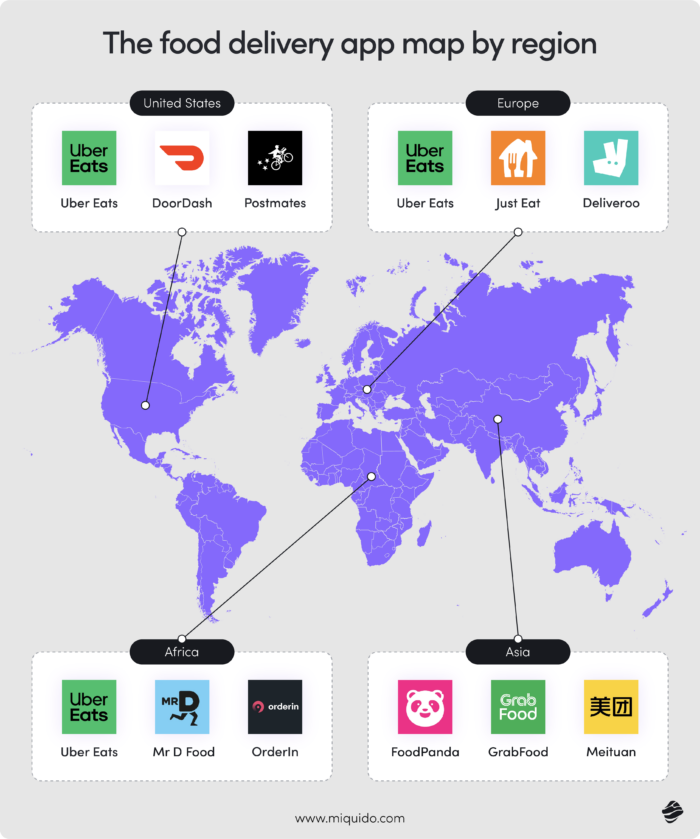
9 must-have food delivery app features to include in your online ordering solution
Food delivery is no longer an innovative service today. The key lies in features and design. A great food delivery service app transforms choosing and ordering food into an adventure and a true pleasure.
It helps users explore new culinary horizons without leaving their couch or organize a quick lunch when racing against deadlines. An intuitive user path must therefore go hand-in-hand with spot-on recommendations and a range of other features that enable the entire process to conclude successfully. Which of these features are essential ingriedients to your success?
#1 Filtered and categorized search
You open a food delivery app to find the perfect meal for yourself. Sometimes you know exactly what you want and where from, while other times you need inspiration. However, there are likely conditions where you’re unwilling to compromise. Maybe you’re on a budget and want only meals on promotion? Well-designed filters help you find exactly what you’re looking for.
Common filters:
- self-pickup
- promotions
- delivery fee
- waiting time
- top-rated
- ratings
- price
- diet
#2 Order history
In most food delivery apps, users have access to their order history. This lets them rediscover meals and restaurants they enjoyed and provides access to invoices, receipts, or delivery details. Users can view comprehensive specifics of previous orders, such as the restaurants or grocery stores they ordered from, the items purchased (including any customizations or special notes), the date and time of the order, and a detailed cost breakdown that includes delivery fees, tips, and taxes.
Reordering is made seamless with options like one-tap reordering for entire meals or grocery lists, as well as the ability to add individual items from past orders to the cart without duplicating the entire order.
For receipt management, these platforms often enable users to download or email receipts, which is particularly useful for expense tracking or reimbursements, and provide a thorough breakdown of the order’s subtotal, taxes, fees, discounts, and tips, offering transparency and convenience for financial management.
#3 Personalized features: personalized feed, push notifications & more
A food delivery app should be a place users eagerly return to. When an app feels like opening a fully stocked snack cupboard after a tough day, sales will take care of themselves! To ensure users find irresistible offerings, advanced recommendation mechanisms are essential.
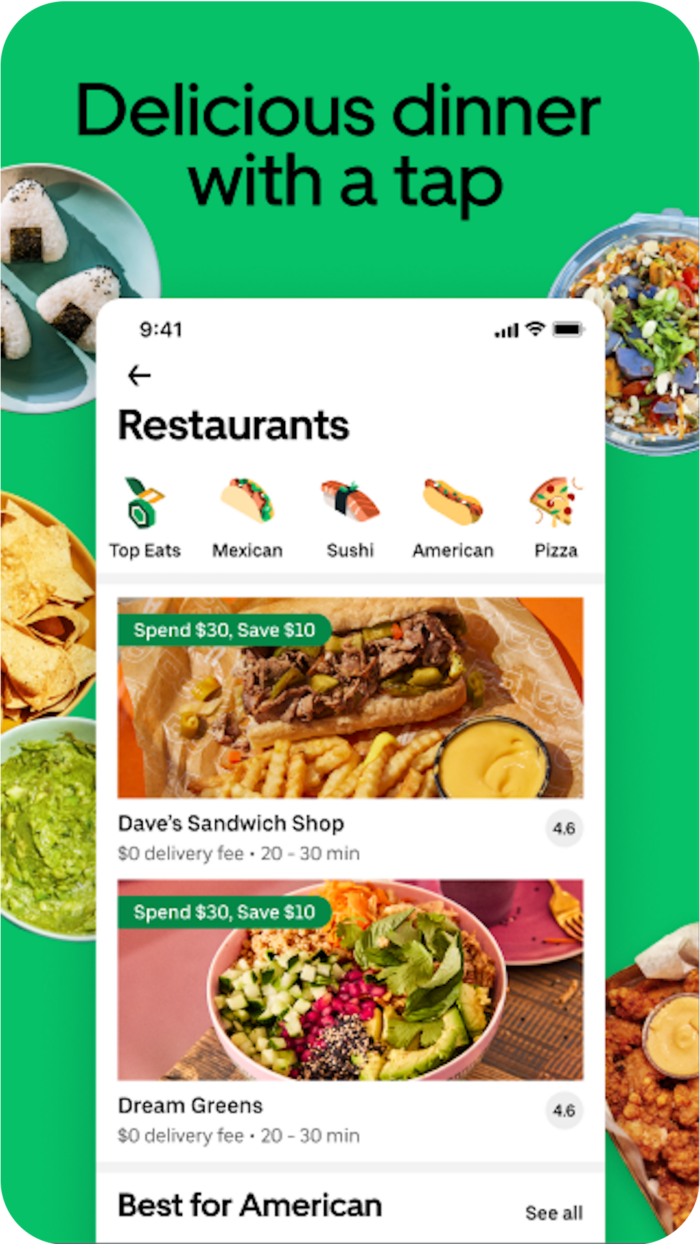
The app should understand a user’s preferences based on the day of the week, season, and more. The better the wall is personalized for user preferences, the more chances of profit there are. For instance, for users focused on promotions, the feed should highlight those prominently. Typically, a personalized feed includes recommendations based on past orders, top promotions tailored to the user, and a “reorder” option.
Personalization can come with various forms, fuelling the conversion rates and strenghtening user’s relationship with the app. Here is the comparision of the main popular food delivery apps in Europe in terms of personalized features.
| Feature/Aspect | Uber Eats | Just Eat | Deliveroo |
|---|---|---|---|
| Wall Personalization | High (dynamic feed) | Moderate (static feed) | High (dynamic feed) |
| Menu Filters/Search | Detailed & adaptive | Basic & generic | Detailed & adaptive |
| Real-Time Tracking | Highly personalized | Standardized | Highly personalized |
| Promotions | Behavior-driven | Less tailored | Behavior-driven |
| Reordering & Favorites | Strong emphasis | Limited functionality | Strong emphasis |
#4 Grocery shopping
The ability to shop for groceries in food delivery apps became widespread only after the pandemic, when the companies noticed the monetization potential in the sector. Before, it was a domain of specialized grocery delivery apps. Instacart, launched in 2012, became a pioneer in app-based grocery delivery. Meanwhile, other food delivery apps like Uber Eats and DoorDash initially focused on restaurant meals and later expanded into grocery delivery.
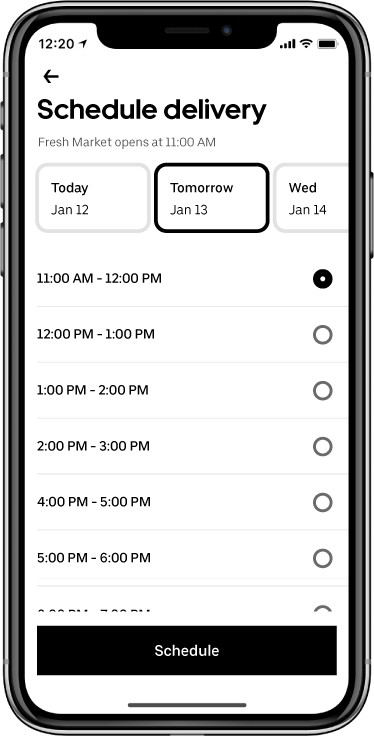
When it comes to grocery delivery, the formula is similar to restaurants: you choose from a catalog of products available at specific stores, confirm your selection, and a courier delivers the groceries to your door. Some applications, like Uber Eats, enable users to schedule grocery delivery in advance.
Grocery delivery strategies – dark stores vs. established grocery stores
The logistics is where the business models of delivery companies often diverge. Most apps rely on partnerships with established grocery stores, where delivery personnel pick items directly from store shelves. This simple model has no strings attatched, not requiring either investments in infrastructure or more integrated management.
However, it comes at a cost, and some companies chose to play it differently, having analyzed profit and loss. A few popular grocery apps, like Gopuff, operate dedicated micro-fulfillment centers (dark stores) instead of relying on brick-and-mortar stores.
Although it requires investment, it provides them with more control over product quality, packaging and delivery speed. In the previous model, it is teamwork: delays independent from delivery person can impact customer satisfaction. In this one, the company has more impact over customer metrics.
#5 Wallet
Payments are a critical factor for users and often play a role in churn rates. Here, the rule is simple: the more payment options, the better. For example, Uber Eats, in addition to standard payment methods like credit cards, digital wallets (Google Pay, Apple Pay), or PayPal, offers an in-app wallet balance.
This is a convenient option for users who value security and ease simultaneously. Some apps also allow users to redeem vouchers and gift cards within this feature. A practical gift for a takeout enthusiast? Why not—after all, the way to the heart is through the stomach!
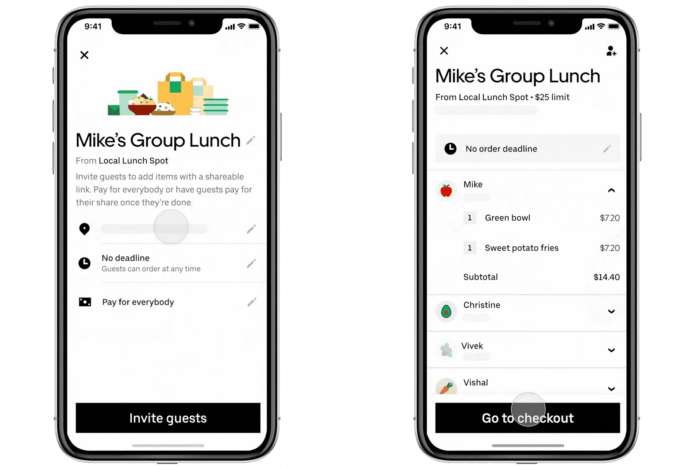
You know that awkward moment at house parties or group events when everyone’s happily ordering food, but then it’s time to split the bill? One person ends up paying, and suddenly, the fun is replaced by awkward cash requests and Venmo exchanges. Uber Eats found a fix for this, implementing pioneering food delivery app features that facilitate co-paying.
It enables you organize group orders where everyone picks and pays for their own food directly in the app. The host sets up the order, sends invites, and participants select and pay for their meals individually. To keep things smooth, you can set a deadline for orders, nudge friends who are taking their time, or finalize the order when ready.
#6 Order tracking
Although this feature holds the least importance for ensuring successful order completion, it is undoubtedly one of the most valuable for users. Who among us hasn’t anxiously watched the order tracking window with a growling stomach? Watching the courier move across the map is an integral part of the in-app experience. It fosters engagement and provides a sense of control.
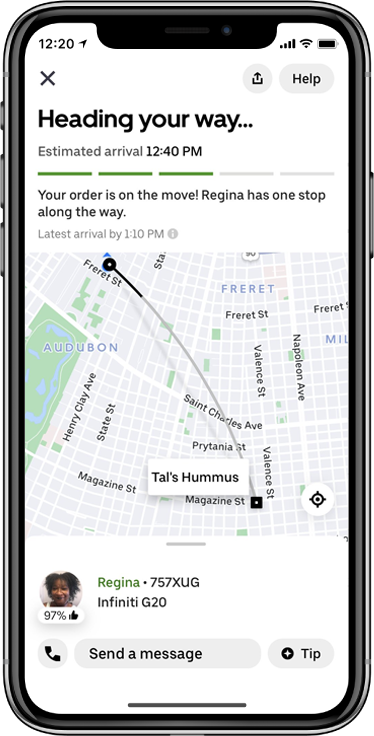
When well-designed, this feature offers users critical information about the status of their orders and deliveries, enabling them to prepare for the courier’s arrival. Ideally, users know whether they need to stay home or can manage a quick errand.
They gain clear timeframes for their order and can respond to delays by contacting the driver or restaurant directly. Additionally, users can assess how long a restaurant took to prepare their meal, drawing insights for future orders.
For the food delivery app, the data collected via this feature is equally significant. It allows businesses to monitor efficiency metrics and evaluate the performance of delivery partners. Companies can see how long it took a driver to pick up an order and deliver it.
While efficiency metrics don’t directly influence payouts for drivers in apps like Uber Eats, data on the distance driven and areas covered (such as boost zones with higher pay rates) is essential for calculating earnings and operational insights.
#7 Feedback options
The ability to leave ratings is an integral feature of food delivery apps, serving multiple parallel functions.
Quality control through user ratings
For the app, it’s a critical component of quality control. These businesses, relying on external freelancers who manage their own schedules and equipment, take on a considerable amount of risk. Providing users with an intuitive rating system that evaluates both the delivery person and the restaurants becomes their strongest tool for maintaining service standards.
Engaging users through feedback
For users, having the option to leave feedback makes them more engaged and likely to continue using the app. This win-win scenario is rooted in simple psychology, particularly the self-determination theory. By inviting users to share their opinions on delivery and food quality, the app satisfies their need for autonomy and validation. This empowerment strengthens the connection between the users and the brand, fostering brand loyalty and repeat use.
Leveraging feedback for personalization
There’s also a third dimension: personalization. User feedback allows the app to tailor the user’s feed, driving revenue. Restaurants whose dishes a user enjoyed most are prominently recommended, while push notifications and in-app promotions highlight discounts at their favorite spots. Platforms like Uber Eats and other major players have successfully implemented this approach to enhance user experience and boost engagement.
#8 Subscription programs
More and more apps are introducing subscription plans, recognizing that users have grown accustomed to this format in other areas and value the benefits they bring. Uber Eats offers the Eats Pass (or Uber One, in some regions), which provides subscribers with benefits such as free delivery on eligible orders and discounts on both food and grocery deliveries.
Similarily, Deliveroo’s subscription service, Deliveroo Plus, focuses on offering free delivery for orders above a certain amount. It also occasionally includes special perks, such as exclusive discounts with partner restaurants.
What makes a good food ordering app?
A food delivery application is judged by many factors, some of which aren’t directly tied to the app itself. Alongside a smooth interface and essential features, the quality of the delivery, the meal itself, and the service at restaurants shape user satisfaction.
While users may understand that not all hiccups are the app’s fault, patience runs thin when delivery or restaurant issues disrupt their experience. For online food delivery apps, the results can be hard to digest. Unforgivable mistakes? Unresolved issues with restaurants or delivery drivers, billing problems without refunds, app crashes, and the inability to track orders. Such errors often leave users craving a switch to competitors.
Though most food delivery apps have similar core functions, the real battle takes place in user interface, app performance, and customer satisfaction. Food delivery features need to be easy and intuitive to handle. Remembering the iconic ad, “You are not you when you’re hungry”. And the last thing you want to do when starving at home after a day full of work or trying to fit in a quick lunch into a busy schedule is get lost in the
Recipe for a successful food delivery app: step-by-step instructions
- Start with the base layer:
Craft a sleek, intuitive interface to form the foundation of the app. This ensures easy navigation and a visually appealing design. - Mix in essential features
Add critical functionalities such as real-time order tracking, flexible payment methods, and AI-powered personalized recommendations. - Incorporate seamless communication
Enable direct messaging with restaurants, live order updates, and a clear channel to report any delivery or order issues. - Add quality control mechanisms
Implement systems to monitor restaurant and delivery performance, leveraging user reviews and ratings for accountability. - Season with issue reporting tools
Create easy-to-use reporting options for resolving complaints like delayed deliveries or incorrect orders. - Blend in collaboration
Partner with high-quality restaurants and dependable delivery personnel to ensure a seamless experience. - Pour in incentives
Motivate stakeholders with rewards like performance bonuses, certifications, or increased visibility on the platform. - Garnish with optional features
Stand out with extras like subscription-based free deliveries, loyalty programs, or gamified user experiences.
Who nailed the recipe? Looking globally, Delivery Hero grabs the biggest piece of the cake, but it’s only due to the fact of covering a few popular apps like foodpanda, Glovo, PedidosYa, tabalat and Beamin under its wings. But if we look at sole players, Uber Eats definetely stands strongest among the global online food ordering apps.
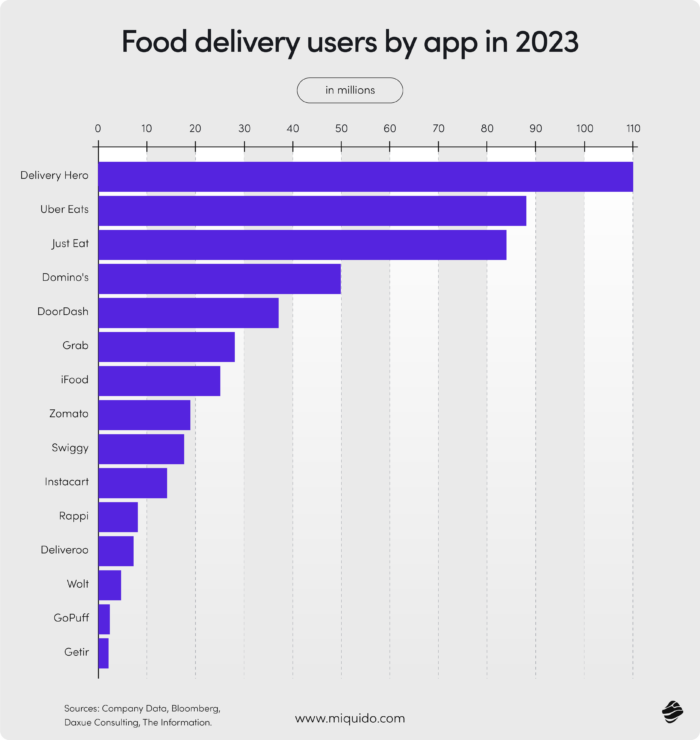
Popular online food delivery app providers
If you’re going to learn, learn from the best—but it’s equally important to learn from others’ mistakes and use them to build your competitive edge. In this comprehensive comparison of functionalities , you’ll get a clear view of the current landscape of food delivery service apps.
Discover which online food ordering app offers the most extensive range of features, makes group ordering seamless, or provides insights into your spending habits and food preferences. It’s a great first step in your food delivery app development!
| Feature | Uber Eats | Glovo | Deliveroo | Zomato |
|---|---|---|---|---|
| Pre-ordering | Limited – Offered in select areas or restaurants. | Available – Allows pre-scheduling of orders. | Available – Can schedule deliveries for future dates and times. | Available – Supports pre-order for dine-in or delivery. |
| Table Reservations | Not supported. | Not supported. | Not supported. | Available – Integrated with restaurants for dining reservations. |
| In-app Food Reviews | Limited – Users can rate orders but detailed reviews are less prominent. | Not supported. | Limited – Primarily focuses on restaurant ratings, not item-level reviews. | Robust – Includes detailed reviews for dishes and restaurants. |
| Group Ordering Features | Limited – Requires manual coordination between users. | Available – Streamlines group orders with shared carts. | Available – Simplifies group payments and order customization. | Limited – Group features are not fully integrated. |
| Loyalty Rewards | Not available. | Not available. | Available – Offers “Deliveroo Plus” for delivery savings and perks. | Available – Includes points for discounts and free meals. |
| Advanced Search Filters | Yes – Supports filters for delivery fee, time, ratings, and dietary options. | Yes – Includes price, ratings, promotions, and more. | Yes – Filters by time, ratings, promotions, and cuisine types. | Yes – Extensive options including diets and pricing. |
| Order History | Detailed – Includes receipts and tax invoices. | Detailed – Offers past orders and receipts. | Detailed – Tracks past orders with receipts. | Detailed – Supports receipts and exportable invoices. |
| Sponsored Items in Feed | Yes – Promoted listings appear in user feeds. | Yes – Highlighted promotions from restaurants. | Yes – Restaurants can sponsor featured listings. | Limited – Not widely used in feeds. |
| Personalized Feed | Yes – Recommends based on past orders and preferences. | Limited – Basic personalization with featured items. | Yes – Tailored feed based on habits and preferences. | Yes – Highlights promotions and past favorites. |
| Grocery Shopping | Limited – Focused on select store partnerships. | Yes – Extensive grocery and non-food delivery options. | Not supported. | Not supported. |
| Wallet/Payment Options | Yes – Includes credit cards, PayPal, app balance, and vouchers. | Yes – Supports multiple payment methods including vouchers. | Yes – Offers credit cards and digital wallets. | Limited – Supports basic credit card and wallet options. |
| Order Tracking | Yes – Step-by-step notifications on order progress. | Yes – Provides live updates from kitchen to delivery. | Yes – Real-time tracking of orders. | Yes – Includes tracking updates. |
| Feedback Options | Yes – Easy feedback for issues or delivery experiences. | Yes – Allows feedback for service improvements. | Yes – Supports reviews for service and delivery. | Yes – Detailed feedback forms. |
| Tipping Options | Yes – Allows tipping drivers after delivery. | Yes – Integrated tipping for delivery partners. | Yes – Tipping options before and after delivery. | Limited – Tipping not widely supported. |
Food delivery app slip-ups and lessons learned
Failure in the food delivery industry can serve as a cautionary tale for understanding what users and stakeholders value. Consider FoodPanda, an early leader in food delivery services that thrived in parts of Asia, from Hong Kong to Thailand. Despite its early success, FoodPanda struggled with inconsistent strategies across markets and aggressive promotions that left a bitter aftertaste for its financial stability.
FoodPanda India, which shut down after four years, added to the company’s woes. Poor onboarding practices for restaurants led to unverified partners and financial fraud. Although the app offered a user-friendly experience, these issues left the company unable to compete with today’s leading food delivery apps.
Munchery, a meal delivery app from the U.S., launched in 2011 with the aim of delivering gourmet food. Despite attracting $50 million in investments, the company closed in 2019.
The problem? Their model didn’t leave much room for profit. Combining gourmet quality with delivery proved an unpalatable mix, as high operational costs and customer dissatisfaction with delivered meals turned the tide against them. Meanwhile, fierce competitors snapped up customers, leaving Munchery on the chopping block.
Turn up the heat and create food delivery apps that make a difference
As you can see, there are quite some big players in the industry already. But the users always seem to have the appetite for more! Take a look at the success story of the Estonian mobility leader, Bolt, that has implemented delivery app features only in 2021 and made a significant success not only in Eastern and Central Europe but also Portugal and Spain.
More and more apps are introducing subscription plans, recognizing that users have grown accustomed to this format in other areas and value the benefits they bring.on a particular chunk of the market like the flutter food delivery app Lunching or go big and try to revolutionize the general market. The world is your oyster, and the new niches are waiting to be conquered! Cook up success with our experienced app developers and season your app to customer taste with bespoke software development.

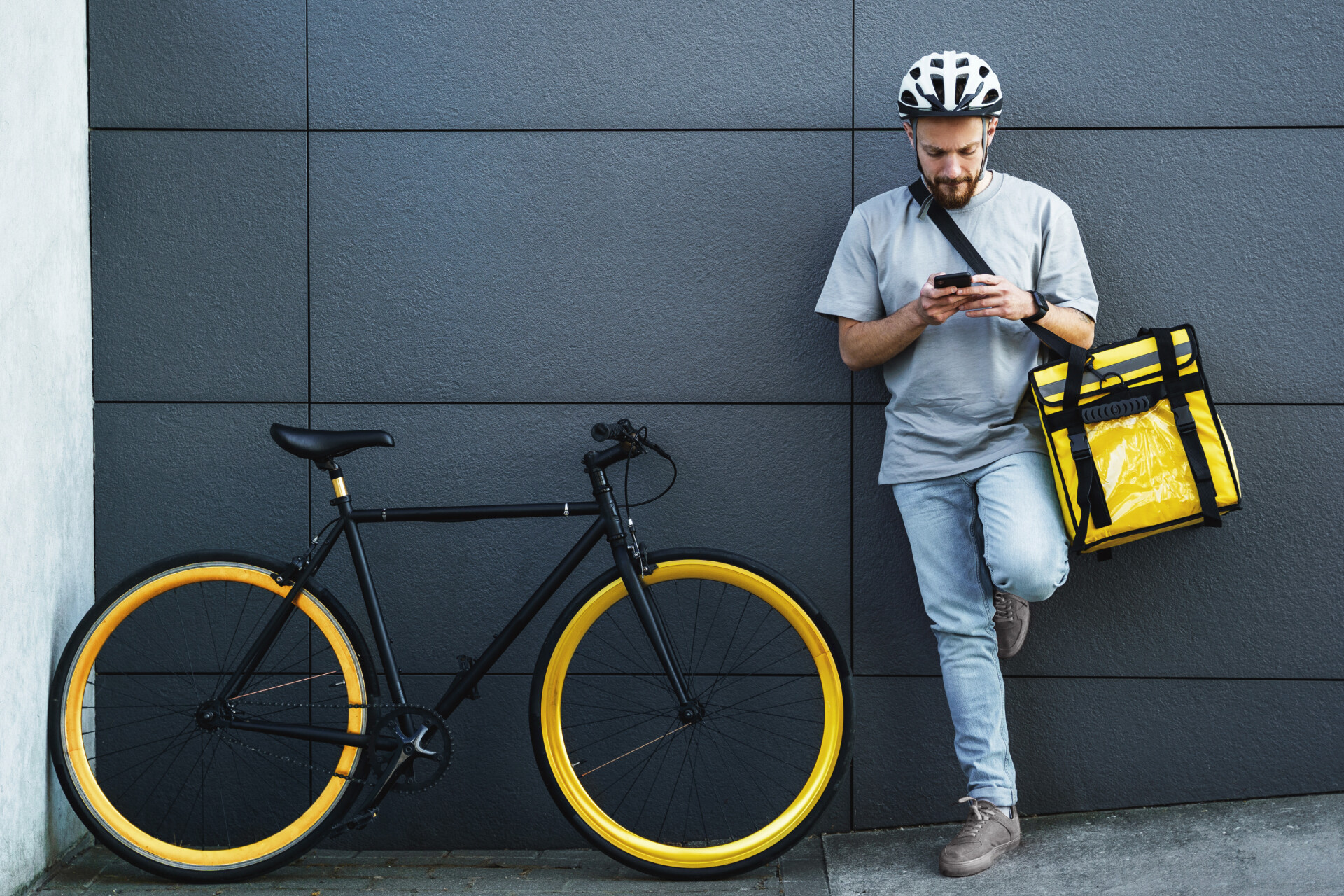


![[header] case study enhancing mobile app performance and loyalty program efficiency in grocery retail](https://www.miquido.com/wp-content/uploads/2025/04/header-case-study_-enhancing-mobile-app-performance-and-loyalty-program-efficiency-in-grocery-retail-432x288.jpg)

![[header] software nearshoring to poland – an ultimate guide](https://www.miquido.com/wp-content/uploads/2025/03/header-software-nearshoring-to-poland-–-an-ultimate-guide-432x288.jpg)
![[header] off the shelf vs. custom ecommerce software](https://www.miquido.com/wp-content/uploads/2020/05/header-off-the-shelf-vs.-custom-ecommerce-software-432x288.jpg)
